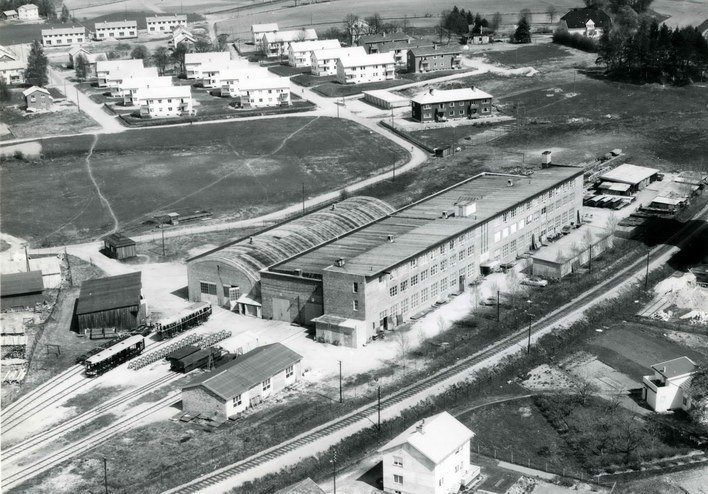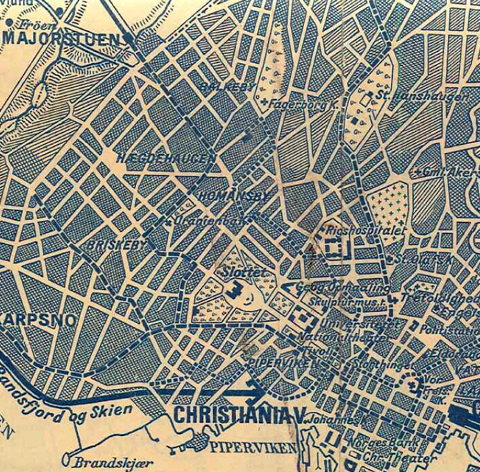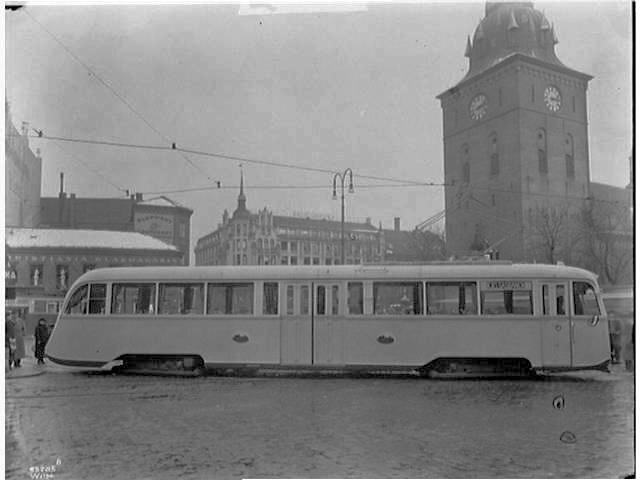|
SM53
SM53, originally designed MBO and colloquially known as Høka, were a class of 58 trams and 50 trailers built by Høka and Hägglund for Oslo Sporveier. The units were used on the Norway's Oslo Tramway from 1952 until 2000. The long and wide trams weighed . They had four motors providing a combined power output of , allowing for a top speed of . The first series of thirty trams in 1950, with delivery in 1952 and 1953. These were designated MBO50. The next order was for new bodies for used Class SS units. The eight motor units were designated MO and nicknamed Chickens, while the twelve trailers were designated TO. These twin-axle units proved unsuccessful and Oslo Sporveier therefore took deliver of more MBO units. The next batch of twelve MBO55 units were delivered in 1957 and the final batch of eight were designated MBO56 and delivered in 1958. These were built for use on the Lambertseter Line, but were found unsuitable for use on light rail service and later moved back ... [...More Info...] [...Related Items...] OR: [Wikipedia] [Google] [Baidu] |
Høka Under Bygging 2
Hønefoss Jernbanevogn- og Karosserifabrikk A/S, trading as Høka and at first known as Hønefoss Karosserifabrikk A/S, was a manufacturer of bodywork for buses, trucks and trains. The company was in existence from 1936 to 1968 and was based in Hønefoss, Norway. Among the company's products is Oslo Tramway's SM53 trams, the Trondheim Tramway's GB Class 3 tram and the Norwegian State Railways Skd 221 shunters. History The company was founded as Hønefoss Karosserifabrikk in 1936 by Major Roald Breien, who wanted to start a mechanical workshop to create jobs in the local area. At first the company had six employees and was based in Arnemannsveien in the city center (now the seat of the city's culture center). To begin with, the company manufactured bus bodywork for domestic coach and bus companies. In addition, the company built tank trucks, fire engines and delivery vans. Høka had the Norwegian rights to a Czech patent for closed, wood-filled steel profiles. In Sweden, this ... [...More Info...] [...Related Items...] OR: [Wikipedia] [Google] [Baidu] |
Høka
Hønefoss Jernbanevogn- og Karosserifabrikk A/S, trading as Høka and at first known as Hønefoss Karosserifabrikk A/S, was a manufacturer of bodywork for buses, trucks and trains. The company was in existence from 1936 to 1968 and was based in Hønefoss, Norway. Among the company's products is Oslo Tramway's SM53 trams, the Trondheim Tramway's GB Class 3 tram and the Norwegian State Railways Skd 221 shunters. History The company was founded as Hønefoss Karosserifabrikk in 1936 by Major Roald Breien, who wanted to start a mechanical workshop to create jobs in the local area. At first the company had six employees and was based in Arnemannsveien in the city center (now the seat of the city's culture center). To begin with, the company manufactured bus bodywork for domestic coach and bus companies. In addition, the company built tank trucks, fire engines and delivery vans. Høka had the Norwegian rights to a Czech patent for closed, wood-filled steel profiles. In Sweden, this ... [...More Info...] [...Related Items...] OR: [Wikipedia] [Google] [Baidu] |
Lambertseter Line
The Lambertseter Line ( no, Lambertseterbanen) is a line on the Oslo Metro which runs from Brynseng to Bergkrystallen. It further shares track with the Østensjø Line along the section from Tøyen to Brynseng. The line runs through a primary residential area of Nordstrand, serving neighborhoods such as Manglerud, Ryen and Lambertseter. The line is served by Line 4 of the metro, which runs every fifteen minutes. This is supplemented by Line 1 that is extended to Bergkrystallen between 6:30 and 19 on weekdays, giving a combined frequency of eight trains per hour. Originally the Lambertseter Line was proposed as an extension of the now closed Simensbråten Line. Planning of a metro started in 1946 and instead of running via Ekeberg the Lambertseter Line was to run via Etterstad. Construction was tied with large-scale construction of housing along the route. As the Lambertseter Line could be completed much earlier than the metro's Common Tunnel, the Lambertseter Line was fi ... [...More Info...] [...Related Items...] OR: [Wikipedia] [Google] [Baidu] |
Briskeby Line
The Briskeby Line ( no, Briskebylinjen) is a line of the Oslo Tramway in Norway. It runs westwards from Jernbanetorget in the city center, passing through the neighborhoods of Briskeby and Uranienborg before reaching its terminus at Majorstuen. The section from Jernbanetorget to Inkognitogata is shared with the Skøyen Line; on this section it connects with the important transport hub Nationatheatret. This part is variously served by route 11, 12 and 13. From the Inkognitogata stop, the line moves through the residential areas around the Royal Palace, in the streets named Riddervolds gate, Briskebyveien, Holtegata and Bogstadveien. The part of the line in Bogstadveien from Majorstuen to Rosenborg is also served by route 19, which operates the Homansbyen Line. When Kristiania Elektriske Sporvei opened the line on 3 March 1894, it was the first electric tramway in Scandinavia. Originally the line ran through Parkveien instead of Inkognitogata and was mostly single track. The trac ... [...More Info...] [...Related Items...] OR: [Wikipedia] [Google] [Baidu] |
Oslo Tramway
The Oslo tram network ( no, Trikken i Oslo, short from ', 'electric') is the tram system in Oslo, Norway. It consists of six lines with 99 stops and has a daily ridership of 132,000. It is operated by , a subsidiary of the municipally-owned who maintain the track and 72 tram vehicles on contracts with the public transport authority . The system operates on standard gauge and uses 750 V DC overhead. Depot, workshops and headquarters are at (at the terminus of lines 13 and 17). There is also a depot at (along lines 18 and 19) that is home to the technical company InfraPartner, which maintains the track for the tram and metro systems in Oslo, and a small office building for . History The first tram in Oslo was opened in 1875 with a short line between Homansbyen west of the city centre, Oslo West Railway Station and a sideline to Grønland, east of the city centre. The first "trams" were in fact horse-drawn vehicles on flanged steel wheels. The first expansion of the line came ... [...More Info...] [...Related Items...] OR: [Wikipedia] [Google] [Baidu] |
Gullfisk
Class B and Class E, normally referred to as ''Gullfisk'' (Norwegian for "goldfish"), were a class of 46 trams built by Strømmens Værksted and Skabo Jernbanevognfabrikk for Oslo Sporveier and Bærumsbanen of Oslo, Norway, in 1937 and 1939. They were the first aluminium trams to operate on the Oslo Tramway and the first bogie trams to operate on street lines. They had contemporary modern electronic equipment, a streamlined shape, and comfortable accommodation. Until 1964, they were also faster than any other Norwegian tramcar or suburban railcar. Six prototype trams were delivered by Strømmen in 1937, with four different motor solutions, from AEG, Siemens, Vickers and Norsk Elektrisk & Brown Boveri (NEBB). None of these were particularly successful, and the 40 serial production trams used conventional motors from ELIN. These were delivered in 1939, with 20 (class E) being used by Oslo Sporveier mainly on the Kjelsås Line, but also on other services. The remaining 20 trams (clas ... [...More Info...] [...Related Items...] OR: [Wikipedia] [Google] [Baidu] |
Malmö
Malmö (, ; da, Malmø ) is the largest city in the Swedish county (län) of Scania (Skåne). It is the third-largest city in Sweden, after Stockholm and Gothenburg, and the sixth-largest city in the Nordic region, with a municipal population of 350,647 in 2021. The Malmö Metropolitan Region is home to over 700,000 people, and the Øresund Region, which includes Malmö and Copenhagen, is home to 4 million people. Malmö was one of the earliest and most industrialised towns in Scandinavia, but it struggled to adapt to post-industrialism. Since the 2000 completion of the Öresund Bridge, Malmö has undergone a major transformation, producing new architectural developments, supporting new biotech and IT companies, and attracting students through Malmö University and other higher education facilities. Over time, Malmö's demographics have changed and by the turn of the 2020s almost half the municipal population had a foreign background. The city contains many ... [...More Info...] [...Related Items...] OR: [Wikipedia] [Google] [Baidu] |
Trams In Gothenburg
The Gothenburg tramway network ( sv, Göteborgs spårvägar) is part of the public transport system organised by Göteborgs Spårvägar, controlled by Västtrafik in the Swedish city of Gothenburg. The system's approximately of single track — making it the largest tram network in Northern Europe — is used by around 200 trams , which serve twelve day-time and five night-time lines with a combined line length of 190 km. These figures are expected to increase when the second stage of ''Kringen'' (short for ''Kollektivringen'', the public transport ring) is finished. The trams perform about 2,000 trips and cover 30,000 km per day. In 2018, 131 million journeys were made (with changes counting as a new journey). History The first tram line in Gothenburg was started in 1879 by the English company Gothenburg Tramway Ltd. This was a horse-drawn tramway, which stretched from Brunnsparken to Stigbergsliden. The city of Gothenburg bought the tramway in 1900, and int ... [...More Info...] [...Related Items...] OR: [Wikipedia] [Google] [Baidu] |
Trams In Stockholm
The Stockholm tramway network forms part of the public transport system in Stockholm, the capital city of Sweden. Beginning with horse trams in 1877, the Stockholm tram network reached its largest extent in 1946. Many of the former suburban tram lines became parts of the Stockholm Metro between the years 1950-1964. In September 1967, in conjunction with the Swedish switch from left-hand to right-hand traffic, the last parts of the once large inner city street running tram network were closed. What little remained of the former network following 1967 were isolated suburban feeder lines to the Metro. However, in 1991 a long heritage line opened to the recreational area Djurgården; and in 2000, the non-radial half-circle line Tvärbanan opened with articulated low floor vehicles connecting an inner ring of Metro and commuter rail stations just outside the inner city proper, with subsequent extensions in 2003 and 2014; and in 2010 the heritage line was extended and converted ... [...More Info...] [...Related Items...] OR: [Wikipedia] [Google] [Baidu] |
Brown, Boveri & Cie
Brown, Boveri & Cie. (Brown, Boveri & Company; BBC) was a Swiss group of electrical engineering companies. It was founded in Zürich, in 1891 by Charles Eugene Lancelot Brown and Walter Boveri who worked at the Maschinenfabrik Oerlikon. In 1970 BBC took over the Maschinenfabrik Oerlikon. In 1988 it merged with ASEA to form ABB. Early History of BBC Brown Boveri BBC Brown Boveri was established in 1891. The company was one of only a few multinational corporations to operate subsidiaries that were larger than the parent company. Because of the limitations of the Swiss domestic market, Brown Boveri established subsidiaries throughout Europe relatively early in its history, and at times had difficulty maintaining managerial control over some of its larger operating units. The merger with ASEA, a company which was praised for its strong management, was expected to help Brown Boveri reorganize and reassert control over its vast international network. Activity in Britain Brown Bove ... [...More Info...] [...Related Items...] OR: [Wikipedia] [Google] [Baidu] |
PCC Streetcar
The PCC (Presidents' Conference Committee) is a streetcar (tram) design that was first built in the United States in the 1930s. The design proved successful in its native country, and after World War II it was licensed for use elsewhere in the world where PCC based cars were made. The PCC car has proved to be a long-lasting icon of streetcar design, and many remain in service around the world. Origins The "PCC" initialism originated from the design committee formed in 1929 as the "Presidents' Conference Committee", renamed the "Electric Railway Presidents' Conference Committee" (ERPCC) in 1931. The group's membership consisted primarily of representatives of several large operators of U.S. urban electric street railways plus potential manufacturers. Three interurban lines and at least one "heavy rail", or rapid transit, operator—Chicago Rapid Transit Company—were represented as well. Also included on the membership roll were manufacturers of surface cars ( streetcars) and ... [...More Info...] [...Related Items...] OR: [Wikipedia] [Google] [Baidu] |
BS Class 1947
BS, B.S., Bs or bs may refer to: Arts and entertainment *BS-, a prefix for all games broadcast for the Satellaview modem via the Japanese Broadcasting Satellite system * "B.S." (song), a song by Jhené Aiko from the album ''Chilombo'' * Team BS, French music collective founded by La Fouine that includes Fababy, Sultan and Sindy *NHK's satellite broadcaster mark, NHK-BS * ''Backstage'' (magazine) * Baritone saxophone, a musical instrument * Bullshit (card game), a card game Businesses and organizations *, a bank in Spain *, a bank headquartered in Spain * Beijing Subway, a transit system * BellSouth, a United States telephone company * Better Serbia (''Bolja Srbija''), a political party in Serbia * ' ("Cipher Bureau"), a Polish cryptography and signals intelligence agency known for its work on German Enigma ciphers in the 1930s * Boy Scouts; see scouting * British International Helicopters (IATA code BS) * British Shipbuilders, a public corporation founded in 1977 * British St ... [...More Info...] [...Related Items...] OR: [Wikipedia] [Google] [Baidu] |







.png)
